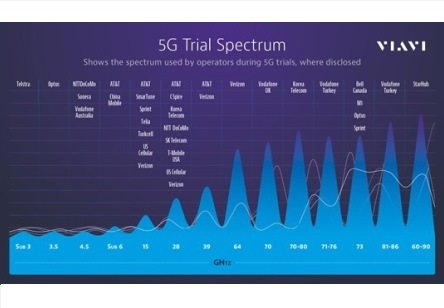A Beginner's Guide to '5G'

The occasion of Mobile World Congress in Barcelona seemed a perfect occasion to drop in on the tech talk amongst wireless people. Like that luxuriously short, two-character, highly nebulous umbrella term that is “5G.”
Let’s start with what 5G isn’t. It isn’t 5 GHz (Gigahertz, which is a frequency/spectrum thing).
It isn’t 5 Gbps (Gigabits per second, which is a speed/throughput thing.) The “G” in “5G” is for “generation.” Fifth generation. Of what? Of mobile stuff. So far so good. However! When you ask involved technologists how they explain 5G to their bosses, a bemused exasperation happens. My favorite so far: “I tell them it’s easy — 5G is everything! Let the imagination run wild.”
Here’s a more serious answer to that question, from another batch of notes: “I tell them that 5G means highly distributed, pretty small cells, running a mix of licensed and unlicensed spectrum.”
IS THERE A THERE THERE?
When drawn onto a paper napkin, that highly distributed network, with pretty small cells, sure looks an awful lot like an HFC (hybrid fiber coax) network. And that explains all the wireless tire-kicking. We appear to be well into the “is there a there there?” stage.
Depending on who’s answering the question, for instance, here’s a sample of what 5G will do for us. First, it’ll retool the airwaves into Gigabit spigots, gleefully flinging gobs of throughput to our handhelds, no matter where we are (or whether we need it).
It’ll also be a major source of connective tissue for the things of the Internet of Things.
Heck, let’s throw in a little Machine-to-Machine (M2M) sensor reading, over low-power WANs (Wide Area Networks). Why not? It’s 5G! It’s everything.
A lot of people are talking about 5G. Here’s the observation that happens with the most frequency from my stashes of notes: “5G is both an opportunity and a threat.”
People who consider 5G a threat worry that it could replace “the last mile,” as in, of the plant that connects homes to headends. (These are the same people who tend to worry about what to worry about.)
People who see 5G as an opportunity are the same people who point out that every single wireless thing in the world needs a wire some of the time. Plus, 5G is coming out of the mobile industry, which is already a bestie in the “frenemy” category, because of established relationships with multichannel video programming distributors for cellular backhaul. The point: All those 5G small cells will need backhaul, too.
TALK NERDY TO ME
The good news is, the technology of 5G breathes vast new life into the landscape of Impressively Nerdy Terms: Millimeter wave and Extremely High Frequencies. MU-MIMO, shorthand for “Multi User-Multiple Inputs Multiple Outputs.” Beam forming. Beam bending. Dynamic time-division duplexing. (HOT.)
All fall into the category of “things that make the airwaves work better.” They’re all ways to optimize how our wireless lives work, behind the scenes.
ANATOMY OF A WIRELESS LAST MILE
One way to look at how 5G might intersect with the wired world is to pick a place, and compare the blueprint of its cellular network, with a blueprint of an HFC network in that same area. What would it take for a mobile carrier to light up a 5G small cell overlay?
Step 1: Determine the radius of the 5G radio/the small cell. How small is small? Millimeter wave radios, because they live way up in the Extremely High Frequency (EHF) zone, don’t go very far. Estimates vary (predictably), but somewhere between 100 and 300 meters is conceivable.
Step 2: Figure out how many small cells will be needed, based on how many people/devices are already inside that footprint. Let’s say it’s Denver. Let’s also say that mobile carriers here service the city’s 650,000-ish inhabitants with 100 macro cells (which is a total guess).
The point is that “densifying” that mobile footprint for 5G will likely involve an order of magnitude increase in small cells. Like if it’s 100 macro cells now, for 3G-4G, ballparking 1,000 small cells for 5G is, as they say, close enough for horseshoes.
WHEN: 2020
Here’s the second most frequent observation about 5G, from my notes: “5G is not clearly defined.”
When might you see 5G, like in your hand, working? Standards bodies — plural — are working on 5G, from the traditional mobile side and the WiFi side.
If the standards finalize by mid-2018, plus another 1.5 year-ish margin for silicon development and manufacturing, 5G looks like a 2020 thing. So we have three years to see which of its many tangents win, lose or draw.
Stumped by gibberish? Visit Leslie Ellis at translation-please.com or multichannel.com/blog.
Multichannel Newsletter
The smarter way to stay on top of the multichannel video marketplace. Sign up below.
